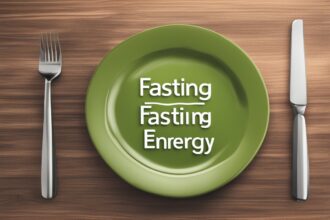Intermittent fasting (IF) has gained immense popularity in recent years as a powerful tool for improving health, managing weight, and enhancing overall well-being. But did you know that intermittent fasting for stamina can also be a game-changer for athletes, fitness enthusiasts, and anyone looking to boost their endurance? By strategically timing your eating and fasting windows, you can train your body to become more efficient at using energy, ultimately leading to improved physical and mental stamina. In this post, we’ll explore how intermittent fasting can support stamina, the science behind it, and practical tips for incorporating it into your routine.
What Is Intermittent Fasting and How Does It Work?
Intermittent fasting is not a diet but a pattern of eating that cycles between periods of fasting and eating. Popular methods include the 16/8 method (fasting for 16 hours and eating within an 8-hour window), the 5:2 diet (eating normally for 5 days and restricting calories for 2 days), and alternate-day fasting. During fasting periods, your body undergoes several metabolic changes, such as switching from burning glucose to burning stored fat for energy through a process called ketosis. This shift can have profound effects on energy levels and endurance, making intermittent fasting for stamina an appealing approach for many.
The key mechanism behind IF’s impact on stamina lies in its ability to improve mitochondrial efficiency—the powerhouses of your cells responsible for energy production. By fasting, you encourage your body to adapt to stress and optimize energy usage, which can translate into better performance during physical activities. If you’re new to IF, check out our guide on Fasting Basics for Beginners to get started.
The Science Behind Intermittent Fasting for Stamina
Research suggests that intermittent fasting can enhance stamina by improving metabolic flexibility—the body’s ability to switch between burning carbohydrates and fats for fuel. A study published in the Journal of Translational Medicine found that fasting can increase fat oxidation, allowing the body to preserve glycogen stores during prolonged physical activity, which is crucial for endurance. This means that with intermittent fasting for stamina, your body becomes better equipped to sustain energy over longer periods without hitting the dreaded “wall.”
Additionally, fasting triggers the release of hormones like norepinephrine and growth hormone, which can boost alertness and physical performance. It also reduces inflammation and oxidative stress, both of which can sap energy and hinder recovery. For more on how fasting impacts energy systems, read our post on Fasting and Metabolic Health.
Benefits of Intermittent Fasting for Physical Endurance
One of the most significant advantages of intermittent fasting for stamina is its potential to enhance aerobic capacity and endurance. By training your body to rely on fat as a primary fuel source during fasting states, you can improve your ability to perform during long-duration activities like running, cycling, or swimming. Here are some key benefits:
- Improved Fat Burning: Fasting helps your body tap into fat reserves, preserving glycogen for when you need quick bursts of energy.
- Enhanced Mental Focus: Many people report heightened clarity and focus during fasting, which can improve performance in endurance sports that require mental toughness.
- Better Recovery: Fasting promotes autophagy, a cellular repair process that can aid muscle recovery and reduce fatigue.
Curious about how fasting affects recovery? Dive deeper into our article on Fasting for Muscle Recovery.
How to Implement Intermittent Fasting for Stamina
Starting intermittent fasting for stamina doesn’t have to be complicated, but it does require planning, especially if you’re an active individual. Here are some actionable steps to get started:
- Choose the Right IF Method: The 16/8 method is often the most sustainable for beginners. Fast for 16 hours (including sleep) and eat during an 8-hour window that aligns with your training schedule.
- Time Your Workouts: If possible, schedule low-intensity workouts during fasting periods to train your body to burn fat. For high-intensity sessions, consider exercising toward the end of your fast or during your eating window.
- Stay Hydrated: Drink plenty of water during fasting periods to prevent dehydration, which can negatively impact stamina.
- Focus on Nutrient-Dense Foods: During eating windows, prioritize protein, healthy fats, and complex carbs to fuel your body for endurance activities.
For meal ideas that complement fasting, explore our collection of Fasting-Friendly Recipes.
Potential Challenges and How to Overcome Them
While intermittent fasting for stamina offers numerous benefits, it’s not without challenges. Some individuals may experience initial fatigue, hunger pangs, or irritability as their body adjusts to the new eating pattern. To minimize these issues, start with shorter fasting windows and gradually increase them over time. Additionally, avoid overtraining during the adaptation phase, as this can exacerbate feelings of low energy.
Another common concern is muscle loss, especially for athletes. However, studies show that IF, when paired with adequate protein intake, does not significantly impact muscle mass. If you’re worried about performance dips, consult a nutritionist or read our guide on Fasting and Muscle Preservation for tailored advice.
Who Should Avoid Intermittent Fasting?
While intermittent fasting for stamina can be beneficial for many, it’s not suitable for everyone. Pregnant or breastfeeding women, individuals with certain medical conditions (like diabetes or eating disorders), and those on specific medications should avoid fasting unless under medical supervision. Always consult a healthcare provider before making significant changes to your eating habits, especially if you’re using IF to boost athletic performance.
Disclaimer: The information provided in this article is for educational purposes only and should not be considered medical advice. Intermittent fasting may not be suitable for everyone, and individual results may vary. Always consult with a qualified healthcare professional or nutritionist before starting any new dietary or fitness regimen, especially if you have pre-existing health conditions or concerns.
References
- Anton, S. D., et al. (2016). “Effects of intermittent fasting on health, aging, and disease.” Journal of Translational Medicine.
- Patterson, R. E., & Sears, D. D. (2017). “Metabolic Effects of Intermittent Fasting.” Annual Review of Nutrition.
- Harvard Health Publishing. (2018). “Intermittent Fasting: Surprising Update.”
- Mayo Clinic. (2020). “Intermittent Fasting: What You Need to Know.”
- de Cabo, R., & Mattson, M. P. (2019). “Effects of Intermittent Fasting on Health and Aging.” New England Journal of Medicine.
This content is for informational purposes only and not a substitute for professional medical advice.






